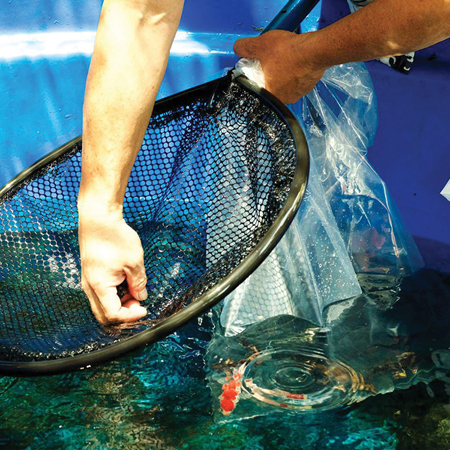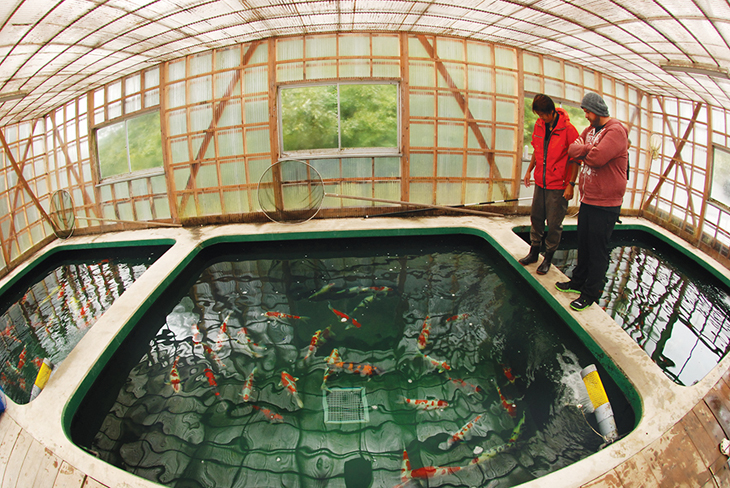
On a warm summer day, watching the water boil with a thousand baby koi mouths climbing, fighting and tumbling on top of each other to get little pellets of food, it is hard not to think about where these creatures are from and how they got there. I often refer to these koi as the small chips from a block of stone being sculpted by a master artist. But before we get into these little chips, let’s first talk about the master artist.
In my 15-plus years of traveling to Japan, I have come across some of the most interesting, diverse, unusual, kind, determined and passionate people I have ever met. Koi breeders in Japan are an interesting bunch. After all, they need the determination of a hardworking farmer but an artist’s creative soul. They need to have strong business sense while maintaining the integrity and honor of their families’ names. Although they are a diverse group, they all seem to share an understanding that they are working toward building the future for koi, themselves and the generations that follow after them.
Noble Goals

I often sit and talk koi philosophy with koi breeders over beer or tea, and I love to ask them what their goals are in breeding koi. Some of the answers I have heard include seeing their farms win the All Japan Koi Show and creating a new bloodline of koi that future breeders will want to use. Also, one of my favorites was a man who told me he is building mud ponds and acquiring brood stock so that his son will be able to have the tools he will need to carry out the future of the farm. Each of these ideas could merit an article all on its own, and rarely do I hear that someone’s goal is to get rich or produce lots of little tosai for sales to the mass-merchant, big-box stores.
The passion, hard work and determination that is put into reaching these noble goals creates a byproduct. That byproduct is the general-grade Japanese tosai you find at quality koi shops around the world. I have heard people describe these koi as culls, saying that these fish are the breeder’s leftovers, not fit for the farm. I couldn’t disagree more, and I feel that it is not the way these koi should be appreciated at all.
The Best of the Best
From here on out I will be using the numbers provided by one of my favorite koi farms. Sp The Hoshino (Koda) family has been breeding koi for four generations now, and each generation has made an important impact on the breeding program of the farm. Masato Hoshino is currently in charge of their breeding program and his goal is to produce koi that are beautiful and can be appreciated for long periods of time. This is in contrast to the goal of creating a grand champion that is often a late bloomer and needs to reach sizes of 3 feet or more. In order to reach these goals, Masato only has roughly 50 opportunities (spawnings) to make an impact on his family’s legacy.
He believes in trying new things every year and so is open to new ideas down the road. However, he also wants to use some of the traditional techniques and philosophies his family has always used.The numbers speak for themselves. Koda Koi Farm produces 20,000 tosai (yearlings) every year from 1.2 million fry (about 1.7 percent). These 20,000 tosai are deemed high enough quality to represent the varieties Masato is producing. Less than 2 percent!
Koda only keeps 2,000 (10 percent) of these tosai to be grown into nisai (2-year-olds). And further, he keeps 200 of these nisai (again, 10 percent) to be grown into 3-year-olds (sansai). The reason he keeps only 10 percent each year (from tosai to nisai to sansai) is simply the limited amount of space and time he can devote to growing out his crop to the standards and goals he and his family strive to achieve.
The remaining 90 percent — 18,000 koi — are what end up around the world at koi shops everywhere. More importantly, these koi are the inspiration that get wide-eyed people into the koi hobby. It is rare that a newly built pond is loaded up with thousand-dollar koi. In fact, the first koi I ever purchased was a small tosai Bekko from an aquarium shop, and I suspect than many of you started similarly as well.

To be honest, the only thing I enjoy more than helping a family pick out their first group of koi is seeing them years later, when they are buying more expensive fish because the original koi they purchased have brought such pleasure. These koi give pond owners a chance to not only learn about how their koi change and develop, but also how their own tastes in koi change and develop. This is why I often describe these “less-than-best” koi as chips off a fine piece of marble that is being made into a masterpiece. However, instead of being swept up into a bin, these chips allow pond owners the opportunity to become a part of the art-making process, continuing where the koi farmer left off — all while loving their koi.


